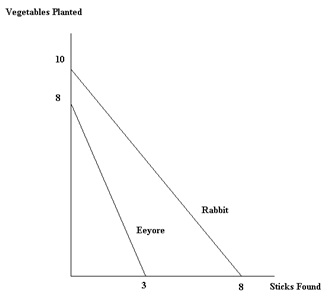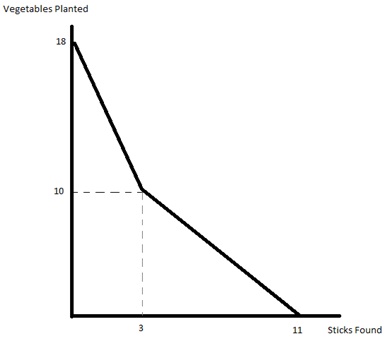Question 1 – PPF’s and Opportunity Cost
Eeyore and Rabbit live in the Hundred Acre Wood. Both can spend their time planting vegetables or looking for sticks. The following graph shows their production possibilities.

a) Who has the absolute advantage in planting vegetables?
b) Who has the absolute advantage in finding sticks?
c) Who has the comparative advantage in planting vegetables?
d) Who has the comparative advantage in finding sticks?
e) What is Eeyore’s opportunity cost for finding a stick?
f) What is Rabbit’s opportunity cost for planting TWO vegetables?
g) Suppose that Rabbit and Eeyore decide to specialize according to their comparative advantages and then trade. What is the range of amounts of vegetables that both would agree to trade in exchange for one stick?
From _____ vegetables up to _____ vegetables for one stick.
h) Consider the bowed outwards PPF we talked about in class. The following graph shows a combined PPF for Eeyore and Rabbit that is bowed inwards. Discuss why a PPF should not be bowed inwards. (Hint: think about opportunity costs and specialization.) Provide an explanation in a few sentences.

Question 2 – Equilibrium and Price Floors
Consider the market for textbooks. It is characterized by the following equations:
Demand: P = 100 - (6/5)Qd
Supply: Qs = (5/2)P - 50
a) Determine the equilibrium quantity in this market: ______
b) Determine the equilibrium price in this market: ______
c) Find consumer surplus in this market: ______
d) Find producer surplus in this market: ______
Now suppose that the government institutes a price floor for textbooks, and this price floor is set at P = $76.
e) Find excess supply with this price floor: ______
f) Find the new consumer surplus with the price floor: ______
g) Find the new producer surplus with the price floor: ______
h) Calculate the deadweight loss in the market for textbooks due to the price floor: _______
i) In words, describe what the deadweight loss represents.
Question 3 – Excise Tax
Consider the gasoline market, which is characterized by the following equations:
Demand: P = 100 - Q
Supply: P = 10 + 2Q
where Q is measured in barrels of gasoline.
a) Determine the equilibrium price in this market: ____
b) Determine the equilibrium quantity in this market: ____
Suppose the government levies an excise tax on the sellers of gasoline of $30 per barrel of gasoline.
c) Determine the equation for the supply of gasoline after the imposition of the tax.
d) What is the price the consumer pays for a barrel of gasoline after the tax is implemented?
e) What is the net price for the seller for a barrel of gasoline after the tax is implemented?
f) How much tax revenue is collected by the government when it implements the tax?
g) What is the total incidence of the tax on the consumer?
h) What is the total incidence of the tax on the producer?
i) What is the deadweight loss created by the tax?
j) What is the change in consumer surplus as a result of the tax?
k) What is the change in producer surplus as a result of the tax?
Question 4 – Agricultural Markets (Leave answers in fractional form or round to two digits past the decimal if necessary)
Consider the agricultural market for corn. The market for corn is characterized by the following equations.
Demand: P = 400 - (1/3)Q
Supply: P = 50 + (1/4)Q
a) Find the equilibrium quantity of corn:
b) Find the equilibrium price of corn:
Suppose the government enacts a price support program in the corn market where the price support, a price floor, is set at a price equal to 300.
c) What is the quantity supplied in this market when the price support is implemented?
d) What price does the consumer pay for corn after the implementation of the price support program?
e) What is the direct government expenditure on corn after the implementation of the price support program? Assume the price support program has no storage costs.
f) What is the consumer’s direct expenditure on corn after the implementation of the price support program?
g) You observe the following under the price support system. The total quantity of corn sold in the market is higher than it was in the equilibrium in part (a), and the price that farmers receive is higher than in part (b). With both of these things seeming to benefit farmers, why might the price support program still not be a good idea?
Question 5 – Grab Bag
1. Consider the market for soccer balls. With the start of the world cup, many individuals suddenly become interested in soccer (you can consider this a change of tastes and preferences). In addition, the new interest in soccer has prompted more firms to enter the market for producing soccer balls. Draw a graph of the soccer ball market, given these two developments. Clearly label your axes, and indicate which curves are shifting (if any). If curves are shifting, please provide an explanation why. Label the new equilibrium point. Also be sure to describe any indeterminacy which may occur and would not be apparent on your graph.
2. Let’s assume you always eat peanut butter with jelly. Suppose that the food and drug administration releases a study that says that peanut butter is good for your health. Peanut butter and jelly are complements. Draw a graph of what happens in the jelly market after this announcement. Clearly label your axes, and indicate which curves are shifting (if any). If curves are shifting, please provide an explanation why. Label the new equilibrium point. Also be sure to describe any indeterminacy which may occur and would not be apparent on your graph.
3. Consider the market for flowers. Suppose there are two segments of the market demand (men’s demand for flowers and women’s demand for flowers). The equations below describe the market for flowers.
Men’s Demand: P = 100 - Q
Women’s Demand: P - 70 - (1/2)Q
Supply: P = Q
a) Determine the equilibrium price of flowers for the market.
b) Determine the equilibrium quantity of flowers in the market.
c) How many of the flowers in equilibrium are being bought by the men?
4. Consider an economy with an inelastic (vertical) demand curve, and an upward sloping supply curve. Joe, a financial expert on television, claims that firms can charge whatever they want to individuals when demand is inelastic, and will charge much higher than the equilibrium price. Bob, another expert, claims that there are market incentives to move the economy towards equilibrium, even in the case of inelastic demand.
Do you agree with Joe that the firms can charge whatever they want? If so, explain your reasoning and the incentives for why the economy will not reach equilibrium.
OR
Do you agree with Bob that the market will reach equilibrium? If so, explain your reasoning and the incentives for why the economy will reach equilibrium.